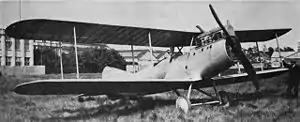| Silver Streak | |
|---|---|
 | |
| Role | Experimental all-metal biplane |
| National origin | United Kingdom |
| Manufacturer | Short Brothers |
| First flight | August 20, 1920 |
| Number built | 1 |
The Short Silver Streak was the first British all-metal aircraft.[1] It was designed and built by Short Brothers at Rochester, Kent, England.[1] Although Flight magazine claimed that it was the first instance of stressed skin construction in the world,[2] it was preceded by a number of Dornier designs, including the Dornier-Zeppelin D.I, which was ordered into production.[3][4]
Development
The Silver Streak was a single-seat biplane with a semi-monocoque duralumin fuselage and duralumin-covered wings.[1] The wing skin was not stressed.[5] The Silver Streak had a conventional landing gear and was powered by a 240 hp (180 kW) Siddeley Puma engine.[1] The Silver Streak was exhibited in July 1920 at the Olympia in London.[1] Registered G-EARQ, it was first flown at Grain on 20 August 1920 by test pilot J. L. Parker.[1] It was later modified as a two-seater and delivered to the Air Ministry in February 1921 for both flight and static testing.[1] The Air Ministry issued a specification for a two-seat reconnaissance biplane and Shorts produced the Springbok based on the Silver Streak.
Specifications

Data from Jackson.[1]
General characteristics
- Crew: one (later two)
- Length: 26 ft 6 in (8.08 m)
- Wingspan: 37 ft 6 in (11.43 m)
- Wing area: 370 sq ft (34 m2) [6]
- Empty weight: 1,865 lb (846 kg)
- Gross weight: 2,870 lb (1,302 kg)
- Powerplant: 1 × Siddeley Puma 6-cylinder water-cooled inline piston engine, 230 hp (170 kW)
Performance
- Maximum speed: 120 mph (190 km/h, 100 kn)
- Cruise speed: 90 mph (140 km/h, 78 kn)
- Range: 450 mi (720 km, 390 nmi) [6]
See also
Related development
References
Notes
Bibliography
- Barnes, C.H. (1967). Shorts Aircraft since 1900. London: Putnam.
- Jackson, A.J. (1973). British Civil Aircraft since 1919 Volume 1. London: Putnam. ISBN 0-370-10006-9.
- Grosz, Peter (1998). Dornier D.I Windsock Minidatafile # 12. Hertfordshire, UK: Albatros Publications. ISBN 9780948414923.
- Gray, Peter; Thetford, Owen (1970). German Aircraft of the First World War (second ed.). London: Putnam. pp. 580. ISBN 9780370001036.
External links
- Norwegian archive images of Silver Streak showing structural details
- "Shorts Silver Streak, all metal aeroplane" FLIGHT, 10 November 1921, complete 3 view photos of Silver Streak, bottom half of page 736